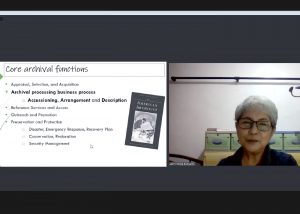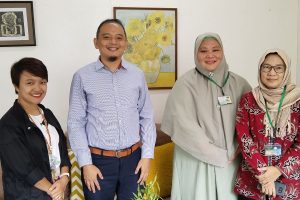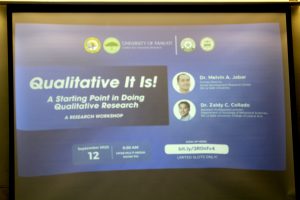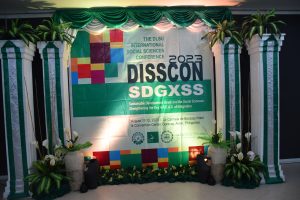Being Attentive to the Bits and Bytes: The Intricate Task of Building an Archive
 The second of SDRC’s webinar series for 2021 met a few false starts on the morning of March 19. The moment was rather harrowing, as the event had attracted so many participants that they could no longer be accommodated on Zoom. This was probably for good reason: The topic at hand was of a more intimate nature than the series’ previous webinars, as it concerned that most precious of cultural artifacts – human memories. So, with the agility it is known for, the Center came together with its resource person and recorded a video of the originally scheduled event. Within a day, “Unboxing the Records: Establishing an Archives Closer to Digital Archiving” by Florbella “Gabi” Bongalos was uploaded, arriving better late, as it can now be viewed and re-viewed by the many who had patiently waited for the webinar, as well as anyone who nurtures an interest in bringing life to stories.
The second of SDRC’s webinar series for 2021 met a few false starts on the morning of March 19. The moment was rather harrowing, as the event had attracted so many participants that they could no longer be accommodated on Zoom. This was probably for good reason: The topic at hand was of a more intimate nature than the series’ previous webinars, as it concerned that most precious of cultural artifacts – human memories. So, with the agility it is known for, the Center came together with its resource person and recorded a video of the originally scheduled event. Within a day, “Unboxing the Records: Establishing an Archives Closer to Digital Archiving” by Florbella “Gabi” Bongalos was uploaded, arriving better late, as it can now be viewed and re-viewed by the many who had patiently waited for the webinar, as well as anyone who nurtures an interest in bringing life to stories.
Ms. Bongalos, a certified archivist who served at the University Archives from 1994 to 2018 (and who had previously been a researcher at the Center in its early days), shared the wealth of her knowledge on archival practice, from its basic principles to the essential characteristics of records, to what preparations would be needed to move into a digital environment. Among the points of interest in her presentation were that an archive could be a What (a record), a Where (a facility), or a Who (an organization); that the types of archives include both church and state, vary in nature from business to medical, and even include repositories for persons (otherwise known as cemeteries); and that the purpose for creating archives can range from establishing a sense of one’s identity to providing evidence for legal cases.
At the center of her presentation were the core functions involved in the archival processing business process, which consist of accessioning, arrangement, and description. She explained that accessioning involves recording receipt or registering the material. Its tasks include preliminary examination of the material, noting its condition and preservation needs, and creating an accession record. Arrangement, meanwhile, is conducted following the principle of provenance (referring to origin, source or creator), the principle of original order (maintaining the material in the same order as when it was created or used), and the principle of hierarchical order (from general to specific, or from the whole collection to its parts). Arrangement tasks consist of determining if the materials have a particular arrangement; determining if they have an original order; identifying if relationships exist between groups of materials; rehousing the materials; arranging the records; and taking down notes. Lastly, description involves providing details and explanations of the materials. Its tasks are to identify the appropriate level of description for the material; describe the appropriate level identified; and provide information or “significant properties” to identify the materials.
Ms. Bongalos also introduced the conceptual standard of the General International Standard Archival Description (ISAD (G)), which is used in archival description, in her presentation. The essential elements of the ISAD (G) are the reference code (which includes country code, repository code, and local code), the title, the creator, dates, and extent of the unit of description.
With regard to the changing environment of archiving records toward the digital, Ms. Bongalos noted that it has affected the meaning of preservation. However, she clarified that the processing of traditional archives is the same as processing digital records, and that both had the same goal – that of being trustworthy archives. This could be achieved by following archival principles and the best practices in traditional archives, which are very much needed in the digital environment. She stressed that archiving is best approached in the manner that specialists do: incrementally (because the work is meticulous), collaboratively (because it is beneficial to work in partnership with those from other fields, such as Information Technology), and iteratively (because of the repetitive nature of archival work).
A lively question and answer session followed, in which she shared her thoughts on:
- the best way to archive documents (“…Your birth certificate, your pictures, your certificate of graduation, your transcript of records – they are all primary records…You can digitize them in high resolution… But keep the original because that is the evidential copy. You can line it with Japanese tissue or Mylar (polyester film)”)
- whether archiving is only for rich societies (“No. That is why there is an emphasis now on diversity, equity and inclusion. It is like we are selective. That’s sad”)
- whether it is necessary for an archivist to know both archival practice and the discipline represented by a collection (“That would be better – it will be reinforced information…when you disseminate information, it is better that the materials you are describing are really the ones you know by heart”)
- how to archive archaeological findings (“For the real physical objects, you need environmental controls – right temperature, right storage, right relative humidity. If you scan or digitize the 3D objects…it is continuous preservation because when you transfer a digital copy to a system, somehow the bits and bytes change. So you have to document the change that will occur when you transfer from the original format to the system…The purpose of digital preservation is to preserve it so that the records can stand alone, whether you change platforms or software or standards”)
- whether there should be a contract for how many years materials can be stored for safekeeping (“Yes, ideally there should be. If it is only for deposit, for example for ten years, it will be a waste of staff time and resources to process…If they do not transfer the rights, we will not be able to share. So what was the safekeeping for?”)
- and how to encourage this kind of important activity among Filipinos, in order to preserve history (“You need to preserve evidence of an event. Without it, we will invent, or provide rumors. Our history will become fake…That is why archiving is now more important because of the authenticity, the evidential character, that should be in place with records… There should be evidence for anything that you do”).
From her devotion to practice, Ms. Bongalos demonstrates that she continues to carry on the mandate of archives, which has existed for more than a thousand years. She answers the extraordinary call to collect, capture, and preserve human testimony, and does so always with the zeal of the generous.





